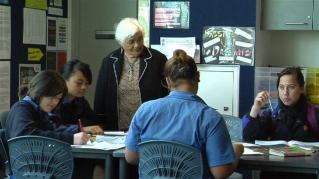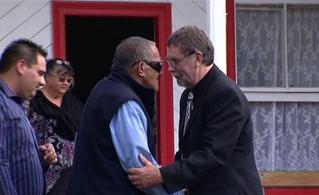Section navigation
The Henderson Intermediate case study is part of the Te Kauhua case studies report (2010), prepared for the Ministry of Education by Dr Ruth Gorinski. As part of their action research for Te Kauhua phase 3, Henderson Intermediate investigated the development of ako-based positive relationships that enhance the presence, engagement and achievement of students, whānau and teachers.
Background
Henderson Intermediate School (HIS) is a decile three, West Auckland School with a roll of 512 students representing 34 different ethnic groups of which 27% identify as Māori. The school has been involved in the Te Kauhua initiative since its inception in 2002.
HIS used an action research approach for professional learning initiatives to engage teachers, students and whānau in teaching and learning decisions that would facilitate positive learning outcomes for Māori. This approach involved a shift from school initiated and driven interactions to a democratic partnership with whānau.
Research Question
In what ways can the development of ako-based positive relationships enhance the presence, engagement and achievement of students, whānau and teachers?
Impetus for the initiative
The impetus for the initiative arose from:
- The realisation that whakawhānaunatanga (developing and nurturing relationships) within a Māori tikanga (ways of doing things) context, is critical to the engagement and participation of Māori families, whānau and communities.
- Data indicated that Māori student attendance, stand downs, suspensions and literacy levels were of concern. Generic school endeavours to engage whānau in classroom learning and teaching processes had been unsuccessful.
What was done?
A whānau group was established that included a kaumatua, kuia, a BOT representative, Te Kauhua facilitators and the principal. This group brokered relationships between school and whānau.
Whānau as learners involved staff sharing social and academic data of Māori students and ranking them against their cohort at HIS and against national norms. This awareness of Māori student achievement levels gave whānau a sense of ownership of their children’s learning and motivated them to act as advocates in their children’s learning experiences. Whānau then contributed to discussions on homework and absenteeism and on a new reporting structure. They also participated in planning and assessment of student work and provided expertise in classrooms. Whanau engaged and contributed in more meaningful ways about curriculum matters. The home school partnerships showed a commitment to power sharing, ako (being both a learner and a teacher) and jointly constructed educational pathways.
A whānau engagement component was made mandatory in all long term planning, including action plans and teacher appraisal documentation. Syndicates were required to engage in action research that focused on an element of whānau involvement in planning and assessment.
What was the impact on student learning and achievement?
- Students whose parents attended whānau hui made significant social and academic achievement gains compared with students whose whānau did not attend.
- No children of attendee whānau were represented in stand down or suspension statistics.
- There was a 45% decrease in the number of unexplained absences of Māori students and an 8% decrease in the total number of absentee days for Māori students school wide.
- There was a significant decrease (26%) in the number of Māori students reading (AsTTle narrative writing) at level 2 or below.
- The average literacy level for students whose parents attended hui shifted two sublevels from 2A to 3P compared to one sublevel from 3B to 3P for children of non attendees.
- The average reading age of whānau hui attendee children was 12.2 years compared to 11.2 years for non attendee students. Both groups had similar reading ages before the hui.
Key learning
- Leadership is critical to developing partnerships with whānau. Leaders need to attend hui, listen and act upon whānau suggestions in a spirit of ako.
- Governance endorsement of policies and practices that promote whānau-school partnerships and resourcing to enable sustainable practices is critical to ongoing success.
- Sharing academic and social data of Māori students is a first step in whānau becoming informed learners.
- Whānau need to be informed so they can become advocates in their child’s educational journey and contribute to the curriculum.
- Teacher engagement with whānau at a classroom level is essential if meaningful interactions are to occur.
- High quality staff professional development is necessary for optimal outcomes.
- Schools must engage whānau on a level where they are able to work collaboratively to identify Māori potential and then jointly construct pathways that will enable that potential to be realised. The presence and engagement of Māori whānau in teaching and learning decision making is key to Māori students achieving their academic and social potential.
Challenges and opportunities
Time for collaborative planning and preparation is perhaps the single biggest challenge in developing effective relationships between school and whānau. This requires ongoing commitment both in terms of people and financial resourcing, but the gains are immense.
Reflective questions
- How can we as a school, best share Māori learner social and academic data with whānau?
- What do whānau want to know?
- How could we find this out?
- How are we as teachers, engaging with whānau at a classroom level?
- What more could we do?
- In what ways is our school wide professional learning programme facilitating the building of teacher- whānau relationships that focus on learning?
Filed under: Productive partnerships | Effective teachers





